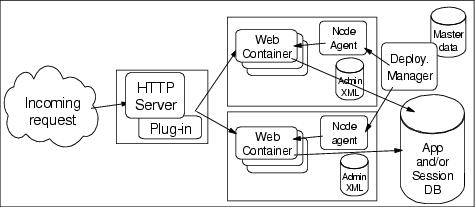Web container clustering and failover
As mentioned before, a WebSphere environment may include several HTTP server instances. Each HTTP server is configured to run the WebSphere HTTP plug-in in its process. Each request coming into the Web server is passed through this plug-in, which uses its configuration information to determine if the request should be routed to WebSphere, and if so, which Web container the request should be routed to (see Figure 9-1). These Web containers may be running on the same machine as the HTTP server, a different machine, or a combination of the two.
In WebSphere V5, several new functions have been added to enhance WebSphere plug-in failover and recovery:
The Web container failover support in WebSphere V5 is provided by three mechanisms:

Figure 9-1 WAS (Web container) high availability
WebSphere is a trademark of the IBM Corporation in the United States, other countries, or both.
IBM is a trademark of the IBM Corporation in the United States, other countries, or both.